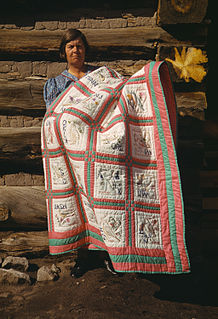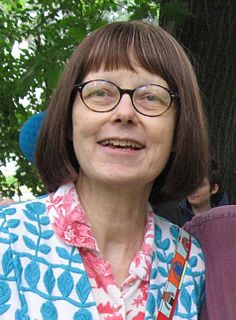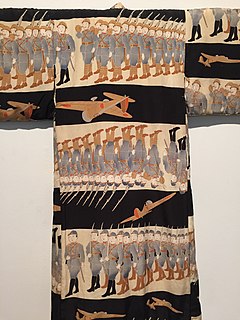
Quilting is the term given to the process of joining a minimum of three layers of fabric together either through stitching manually by hand using a needle and thread, or mechanically with a sewing machine or specialised longarm quilting system. An array of stitches is passed through all layers of the fabric to create a three dimensional padded surface. The three layers are typically referred to as the top fabric or quilt top, batting or insulating material and the backing.

Patchwork or "pieced work" is a form of needlework that involves sewing together pieces of fabric into a larger design. The larger design is usually based on repeating patterns built up with different fabric shapes. These shapes are carefully measured and cut, basic geometric shapes making them easy to piece together.

A quilt is a multi-layered textile, traditionally composed of three layers of fiber: a woven cloth top, a layer of batting or wadding, and a woven back, combined using the technique of quilting, the process of sewing the three layers together. The pattern of stitching can be the key decorative element if a single piece of fabric is used for the top of a quilt, but in many cases the top is pieced from a patchwork of smaller fabric pieces; and the pattern and color of these pieces will be important to the design.

Fiber art refers to fine art whose material consists of natural or synthetic fiber and other components, such as fabric or yarn. It focuses on the materials and on the manual labour on the part of the artist as part of the works' significance, and prioritizes aesthetic value over utility.

Bingata is a traditional stencilled resist dyeing technique originating in Okinawa Prefecture. Bingata typically features a busy pattern of repeating nature motifs such as fish, flowers and fauna in a number of bright colours. Bingata is worn during traditional Ryukyuan festivals and traditional arts performances.

The history of quilting, the stitching together of layers of padding and fabric, may date back as far as 3400 BCE. For much of its history, quilting was primarily a practical technique to provide physical protection and insulation. However, decorative elements were often also present, and many quilts are now primarily art pieces.
Marie Daugherty Webster was a quilt designer, quilt producer, and businesswoman, as well as a lecturer and author of Quilts, Their Story, and How to Make Them (1915), the first American book about the history of quilting, reprinted many times since. She also ran the Practical Patchwork Company, a quilt pattern-making business from her home in Wabash, Indiana, for more than thirty years. Webster's appliquéd quilts influenced modern quilting designs of the early twentieth century. Her quilts have been featured in museums and gallery exhibition in the United States and Japan. The Indianapolis Museum of Art holds the largest collection of her quilts in the United States. Webster was inducted into the Quilters Hall of Fame in 1991. The Marie Webster House, her former residence in Marion, Indiana, was listed on the National Register of Historic Places in 1992, was designated a National Historic Landmark in 1993, and serves as the present-day home of the Quilters Hall of Fame.
Quilt art, sometimes known as art quilting, mixed media art quilts or fiber art quilts, is an art form that uses both modern and traditional quilting techniques to create art objects. Practitioners of quilt art create it based on their experiences, imagery, and ideas rather than traditional patterns. Quilt art generally has more in common with the fine arts than it does with traditional quilting. This art is generally either wall hung or mounted as sculpture, though exceptions exist.
Joan Snyder is an American painter from New York. She is a MacArthur Fellow, a Guggenheim Fellow, and a National Endowment for the Arts Fellow (1974).
Katherine Westphal was an American textile designer and fiber artist who helped to establish quilting as a fine art form.
Yvonne Porcella was an American art quilter.

Mary Catherine Lamb was an American textile artist, whose quilts reframed traditional Roman Catholic iconography. Recycling vintage textiles popular during the mid-20th Century, she both honored and affectionately skewered her Catholic upbringing.
Pecolia Warner was an American quiltmaker.
Malcolm Armstrong Harrison was a New Zealand clothing designer and textile artist.
Martha Neill Upton was a watercolorist, sculptor and studio quilt artist. Her quilted tapestries helped quilts become seen as fine art, rather than craft work, during the early 1970s. Her quilts were shown in the first major museum exhibition of non-traditional quilts, The New American Quilt at New York's Museum of Arts and Design, then called the Museum of Contemporary Craft, in 1976.
Martha Cole is a Canadian artist. She is known for her work with textiles, landscape, and artist's books, addressing themes of inter-contentedness, sustainability, and protection of ecological diversity. She currently resides in Disley, Saskatchewan. Cole's high school art teacher, Helmut Becker encouraged her to pursue a career in art. She was an instructor in the Extension Division, Fine Arts and Humanities, University of Regina.

Jane Dunnewold is an textile artist and author. She had been the president of the Surface Design Association.

Kimono that carried designs depicting scenes from contemporary life became popular in Japan between 1900 and 1945. Such designs are now known as omoshirogara (面白柄) — literally, "interesting" or "novelty" designs. They include traditional Japanese apparel worn by men, women and children, including nagajuban (underkimono); haori ; haura ; and miyamairi kimono. The designs that concentrate on reflecting military and political concerns in Japan during Japan's war years (1931-1945) are commonly referred to as propaganda kimono. Omoshirogara garments were typically worn inside the home or at private parties, during which the host would show them off to small groups of family or friends.
Lucy Marie (Young) Mingo is an American quilt maker and member of the Gee's Bend Collective from Gee's Bend (Boykin), Alabama. She was an early member of the Freedom Quilting Bee, which was an alternative economic organization created in 1966 to raise the socio-economic status of African-American communities in Alabama. She was also among the group of citizens who accompanied Martin Luther King Jr. on his 1965 march from Selma to Montgomery, Alabama.
Bisa Butler is an American fiber artist known for her quilted portraits and designs celebrating black life. She has exhibited at the Smithsonian Museum of American History, the Epcot Center, the National Underground Railroad Freedom Center, and other venues.









